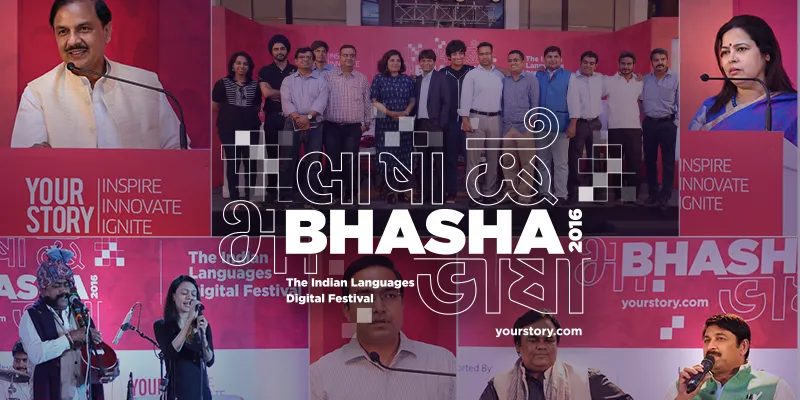How this bootstrapped startup crossed 100,000 app downloads within 8 weeks of its launch
Over the last two years, several studies have shown that the next wave of Internet users will come from the rural pockets of India and Internet companies that produce exclusively English content might not be able to make hay. It’s safe to say that if languages spoken and written in India were to be compared to an iceberg, English is just the proverbial tip.
"If you talk to a man in a language he understands, it goes to his head. If you talk to him in his language, it goes to his heart."
-Nelson Mandela

The majority of the Indian population reads local language newspapers and can write in their local language. However, they are often unable to communicate in their own language via the digital medium. Lipikaar, founded in 2011, aims to eliminate that very barrier, offering users 18 language options that work on common text editors like MS Office, website and browser plugins, and a keyboard app for Android phones as well. Lipikaar was showcased at the first-ever Indian language digital festival, Bhasha, on March 11 in New Delhi, supported by the Ministry of Culture, Government of India, and exclusive language partner Reverie Language Technologies.
In January 2016, Lipikaar launched the free version of their app and in the first eight weeks, they crossed 1 lakh monthly active users (more on this in the ‘How to build a superstar product’ section).


YourStory covered Lipikaar back in 2011, at a time when everyone wasn’t so gung-ho and aware about the need to cater to this audience. Neha Gupta, Founder Lipikaar, shares with us how she chanced upon the idea,
"The core concept and method behind Lipikaar was invented and patented by my father, Jugal Gupta, for his business, which deals in LED-based programmable scrolling display systems. He wanted to supply these displays to banks in remote corners of India where the messages are displayed in the local language. For example: होम लोन्स. ATM सेवा. क्रेडिट कार्ड सुविधा. These messages need to be changed often by the bank operator or the bank peon using an ordinary keyboard. We soon realised this need existed on the PC and Web as well, and hence we started building Lipikaar."
Why should a user pick Lipikaar?
The mark of a great product is one that is researched well and solves the problem for the end-user with minimum intervention. The user must feel the ease of use and Lipikaar hits the nail on its head with its features.

- No fluency in English required: Often, transliteration requires users to phonetically spell Hindi (or any Indian language) words in English. This requires users to be comfortable with English and involves trial and error for words used in professional communication. To use Lipikaar, users only need to know the sounds of English alphabets. Using the typing method, any word can be typed accurately and effortlessly without any guesswork.
- Simple and intuitive typing method: Lipikaar is based on phonetic sounds of the alphabets and employ the commonly used QWERTY keyboard. Existing keyboard layouts like Inscript requires users to memorise key positions or use stickers, which might be difficult for them to adapt to.
Over the past five years, Lipikaar’s audience base has been broadening. This has helped reaffirm the team’s belief in its robust product. Neha says that the early adopters were mostly professionals who wanted to use Lipikaar for their work such as lawyers, authors, teachers, small business owners, and advertisers. Currently, over 40 per cent of Lipikaar’s paid users are the ones who use Lipikaar for personal work like writing a Facebook post, sending e-mails to loved ones, and documenting recipes – another indication of the penetration of languages across all digital and print media.

A Lipikaar PC license for individual users is Rs.1,749. Neha says that their sales primarily come through their website and through the offline dealers they have tied up with. Lipikaar also offers web-plugin licenses for websites. They boast of 3,000 paid customers for the PC version with 15 per cent of these customers coming back. They also have bulk licensing deals with companies like HCL, ITC, and WhatsOnIndia.
How to build a superstar product
Neha isn’t a first-time entrepreneur with Lipikaar. Before Lipikaar, she was a co-founder at an e-commerce startup. From a time when the naysayers said that Lipikaar wasn’t a viable business, mostly bootstrapped with some angel investment, Neha now has investors chasing her. She shares her mantra for building a product that will not just survive, but thrive in the market.
- Start Small - Don’t try and build everything in the first version. With the mobile app, we kept it super simple and released the first version in just three weeks with no fancy UI, and just basic functionality. The early adoption and feedback told us what customers care about and what features are a must-have versus what can wait for later.
- Be metrics obsessed - Track everything your users do with your product - how they interact, when do they use it, what makes them abandon your product. This has helped me gain tremendous insights and improve the product. It also helps while pitching your product to potential partners. People take you more seriously when you have data to back your claims.
- Be open to change - In the early years, we focussed more on PC-based products, but in the last two years, we have focussed more on the mobile app and website plugins. The adoption on the mobile has helped us prove that Lipikaar truly solves a problem and it’s not just another keyboard. The mobile app has helped boost our sales on the PC as well with people wanting a consistent typing experience across devices.
Challenges and roadmap
“People who have decision-making powers usually speak English and hence are able to relate better to transliteration than Lipikaar. They are not able to see how Lipikaar works better for their non-English speaking customers”, says Neha on the challenges she faces. She adds that large companies, where sizeable sales are possible, move slowly. “One of our large deals took nine months to close and a further three months to complete payment.”
Speaking about Indian customers, Neha points out that there is a resistance in the Indian market to pay for software. She adds, “Even Adobe, Microsoft, and others have not been able to sell to consumers and are victims of rampant piracy.” Further, she says that since paid apps don’t work well in India, Lipikaar is exploring other monetisation strategies on the mobile.
Lipikaar’s prime focus now is on building partnerships and increasing the reach of its products across the PC, Web and Mobile. She says, “We have seen a high attach rate (> 75%) for the PC version with MS Office products like Word and Excel. So we are exploring collaborations on that front. Given the traction we have seen on mobile, we are exploring partnerships with smartphone manufacturers as well. With more and more websites now supporting Indic content, we are pushing our web plugin more aggressively as well.”







